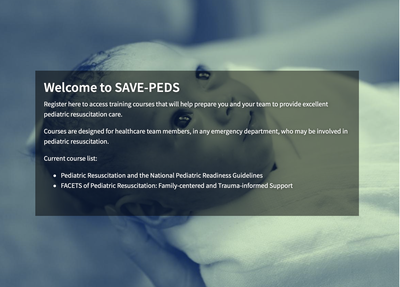Checklist & free modules on family-centered and trauma-informed care to improve pediatric resuscitations
- Published May 31, 2022

Reviving a child can be a complex and stressful procedure for all involved, but limited resources exist to help emergency department teams consistently assess and improve their pediatric resuscitation processes.
Dr. Sage Myers and Dr. Nancy Kassam-Adams, both of Children’s Hospital of Philadelphia and University of Pennsylvania’s Perelman School of Medicine, saw a clear need to help emergency departments — especially the more than 4,500 general departments that don’t regularly treat children — be better prepared to care for children and families during pediatric resuscitations.
Through a 2016-2021 Emergency Medical Services for Children (EMSC) Targeted Issues grant, they created research-based tools that promote quality improvement in pediatric resuscitation.
“All of us want to deliver the best possible care to children facing life-threatening illness and injury,” Myers says. After working on a quality improvement tool for pediatric resuscitation at her hospital, she saw the potential to help others evaluate their emergency department’s practices and develop institution-specific improvements.
Since launching the Targeted Issues Program in 1991, EMSC has awarded over $60 million for 115 projects in 29 U.S. states and the District of Columbia. Those projects have translated scholarly work into practical resources, including toolkits, videos and trainings, to drive improvements in pediatric emergency care.
For their Targeted Issues project, Myers and Kassam-Adams drew on two related principles associated with better health outcomes and improved experiences: patient- and family-centered care (encouraging patient and family perspectives and participation in care-related decisions) and trauma-informed care (offering care in a way that minimizes the potential for psychological trauma).
Those aren’t new concepts — and they’re approaches EMSC has long encouraged, Kassam-Adams says: “EMSC has always been focused on the impact for kids and families, making sure that in addition to getting better physically, they have the best emotional recovery possible.”
Using their Targeted Issues research, including expert interviews and literature reviews, Myers and Kassam-Adams developed a set of recommended behaviors (the FACETS, or Family-Centered and Trauma-Informed Support, of pediatric resuscitation), and launched two free tools:
- The Observation Checklist for Pediatric Resuscitation, based on the FACETS framework, which lists actions emergency department teams can use to assess and improve resuscitation practices, such as providing families with regular status updates.
- The SAVE-PEDS online learning platform, which currently hosts two free courses: a 1-hour FACETS module that prompts learners to consider family-centered, trauma-informed responses to different scenarios, and a course on best practices for pediatric resuscitation. CME awarded for module completion.
The new resources can be used by departments as part of quality improvement initiatives or by individuals looking to improve skills, and are designed to meet the needs of any health care team members who could play a part in pediatric resuscitations, from EMS professionals, doctors, advanced practice providers, nurses and respiratory technicians to social workers and chaplains.
Looking ahead, Myers and Kassam-Adams hope to add more resources to SAVE-PEDS and grow the site’s ability to help community hospitals set up and sustain quality improvement programs. Ultimately, they hope their Target Issues project will help emergency department teams prioritize family-centered and trauma-informed care while improving their capability and confidence in resuscitating children.
To use the new pediatric resuscitation resources in your work, download the checklist from HealthCareToolbox.org and sign up for the free courses at SavePeds.org.